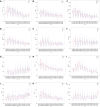Spatial and temporal analysis and forecasting of TB reported incidence in western China
- PMID: 39272092
- PMCID: PMC11401417
- DOI: 10.1186/s12889-024-19994-6
Spatial and temporal analysis and forecasting of TB reported incidence in western China
Abstract
Objective: Tuberculosis (TB) remains an important public health concern in western China. This study aimed to explore and analyze the spatial and temporal distribution characteristics of TB reported incidence in 12 provinces and municipalities in western China and to construct the optimal models for prediction, which would provide a reference for the prevention and control of TB and the optimization of related health policies.
Methods: We collected monthly data on TB reported incidence in 12 provinces and municipalities in western China and used ArcGIS software to analyze the spatial and temporal distribution characteristics of TB reported incidence. We applied the seasonal index method for the seasonal analysis of TB reported incidence and then established the SARIMA and Holt-Winters models for TB reported incidence in 12 provinces and municipalities in western China.
Results: The reported incidence of TB in 12 provinces and municipalities in western China showed apparent spatial clustering characteristics, and Moran's I was greater than 0 (p < 0.05) over 8 years during the reporting period. Among them, Tibet was the hotspot for TB incidence in 12 provinces and municipalities in western China. The reported incidence of TB in 12 provinces and municipalities in western China from 2004 to 2018 showed clear seasonal characteristics, with seasonal indices greater than 100% in both the first and second quarters. The optimal models constructed for TB reported incidence in 12 provinces and municipalities in western China all passed white noise test (p > 0.05).
Conclusions: As a hotspot of reported TB incidence, Tibet should continue to strengthen government leadership and policy support, explore TB intervention strategies and causes. The optimal prediction models we developed for reported TB incidence in 12 provinces and municipalities in western China were different.
Keywords: Forecasting; Holt-Winters; Reported incidence; SARIMA; Spatial and temporal analysis; Tuberculosis.
© 2024. The Author(s).
Conflict of interest statement
The authors declare no competing interests.
Figures




Similar articles
-
Spatiotemporal characteristics and the epidemiology of tuberculosis in China from 2004 to 2017 by the nationwide surveillance system.BMC Public Health. 2020 Aug 26;20(1):1284. doi: 10.1186/s12889-020-09331-y. BMC Public Health. 2020. PMID: 32843011 Free PMC article.
-
Spatiotemporal analysis and forecasting model of hemorrhagic fever with renal syndrome in mainland China.Epidemiol Infect. 2018 Oct;146(13):1680-1688. doi: 10.1017/S0950268818002030. Epub 2018 Aug 6. Epidemiol Infect. 2018. PMID: 30078384 Free PMC article.
-
[Temporal-spatial distribution of tuberculosis in China, 2004-2016].Zhonghua Liu Xing Bing Xue Za Zhi. 2020 Apr 10;41(4):526-531. doi: 10.3760/cma.j.cn112338-20190614-00441. Zhonghua Liu Xing Bing Xue Za Zhi. 2020. PMID: 32344476 Chinese.
-
Forecasting the incidence of tuberculosis in China using the seasonal auto-regressive integrated moving average (SARIMA) model.J Infect Public Health. 2018 Sep-Oct;11(5):707-712. doi: 10.1016/j.jiph.2018.04.009. Epub 2018 May 3. J Infect Public Health. 2018. PMID: 29730253 Free PMC article.
-
Analysis of spatial-temporal dynamic distribution and related factors of tuberculosis in China from 2008 to 2018.Sci Rep. 2023 Mar 27;13(1):4974. doi: 10.1038/s41598-023-31430-0. Sci Rep. 2023. PMID: 36973322 Free PMC article.
References
-
- World Health Organization. Global tuberculosis report 2022. Geneva: World Health Organization. 2022. Available from: https://www.who.int/publications/i/item/9789240061729.
MeSH terms
LinkOut - more resources
Full Text Sources
Medical
Research Materials

